Costa Rica is a great destination for birding enthusiasts around the world. Given the rich biodiversity of the region and the conscious conservation efforts, you are never too far away from a good birding spot. San Gerardo de Dota is one such small town, about two hours’ drive away from the country capital San Jose. This little village enveloped in the Talamancan mountain range is home to several species of exquisite birds, including the elusive Resplendent Quetzal. So Quetzal spotting in San Gerardo always tops the list of things to do for the visitors of this idyllic cloud forest covered mountain town.
Why is the Resplendent Quetzal special?
Largest of the Trogon family, Resplendent Quetzal is considered one of the most beautiful birds in the world. The brilliantly colored green-red plumage of the Quetzal seems worthy of its name, resplendent!
As with most bird species, the male Quetzal looks even more attractive than its female counterpart. Its iridescent green body is complemented with a red breast. A crown adorns its head. But it is the streamer-like elongated upper tail that completes its fancy look. A Resplendent Quetzal in flight is a sight to behold. The features of this bird are so striking that the mythical species used to be regarded sacred among the ancient native Americans.
But, despite its elegant looks, the Replendent Quetzal has its own share of challenges. The thick feathers are not just for ornamentation, they work as a protective cover to the otherwise thin skin of the bird. Carrying the weight of the tail means this small bird cannot afford long flights. However pretty the Quetzal may seem, it is prey for other birds like hawks, eagles, emrald toucanets and Quetzal eggs and babies are prey for squirrels and kinkajous.
The eating habits and parenting habits of the Resplendent Quetzal also have a specific style. You are like to learn more about these when you go on a Quetzal spotting tour.
Pictured below (from left): Male from back side, male from front side, female.



Where can you find Quetzal in Costa Rica?
Resplendent Quetzals are found in the mountainous cloud forest regions from Mexico to Panama, covering all of Central America. In fact, it is now the national bird of Guatemala. But the chances of a Quetzal spotting is likely higher in Costa Rica than in Guatemala.
In places like Curi Cancha Reserve in Monteverde, these green birds hide camouflaged in the green leaves of their favorite aguacatillo trees. Nevertheless, during their breeding season between the months of April and June, it is comparatively easier to spot this otherwise elusive bird.
Los Quetzales National Park is also known to be home for the Resplendent Quetzal. Lying adjacent to the national park limits, the village of San Gerardo de Dota is another such great spot. In fact, this is where we have had our Quetzal sightings, on multiple occasions.
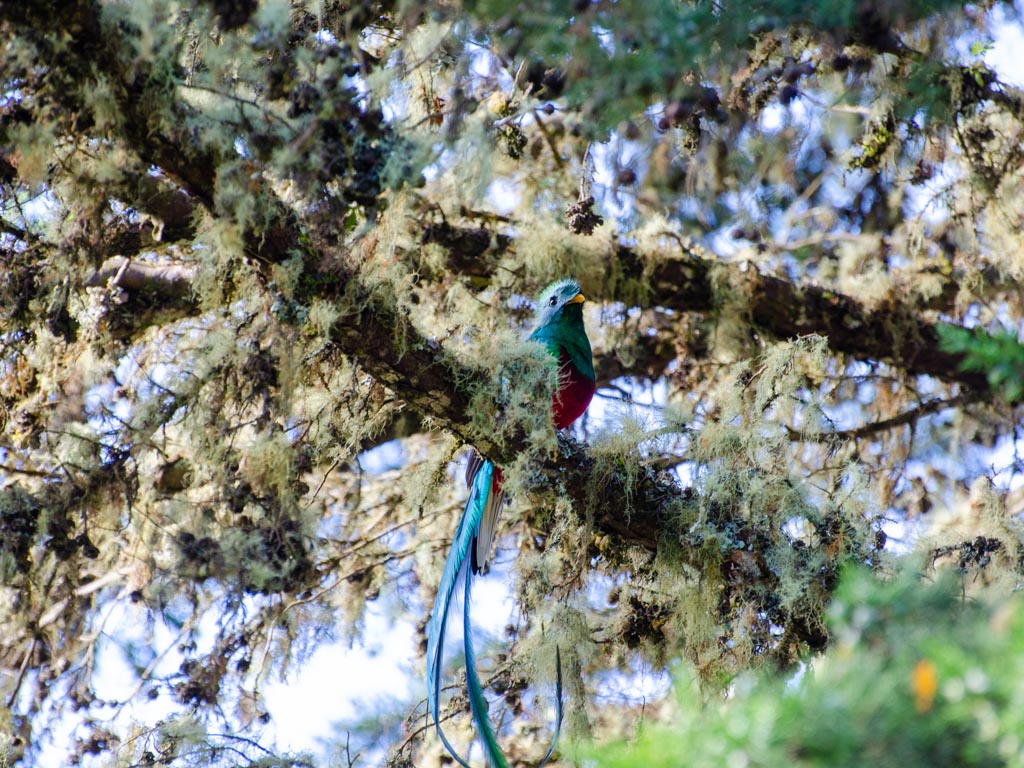
Quetzal Spotting – Guided Tour or Self-guided?
We love discreetly following the sounds and movements of birds in order to track them and photograph them. That is why we mostly prefer to venture on our own for our bird-watching sprees. And on most occasions, we end up immensely satisfied with the outcome, and more importantly the process. But self-guided birding does require a great amount of patience though.
However, there is no denying that when you are accompanied by a professional guide, your chances of bird sightings increase significantly. You also get to learn more from the field experts about the behavior of the birds.
Quetzal spotting is not an easy task. You have to have a very keen eye for spotting this elusive bird that blends so well with its green surroundings. So, our recommendation is to go for a guided tour, at least the first time. There are some great guides in San Gerardo de Dota who know the area really well and thus the hideouts of the Quetzals. That is why Quetzal Tour is a standard offering in San Gerado, independent of generic birding tours (which are great too!)
Even if you opt for a self-guided walk for Quetzal spotting in San Gerardo de Dota, chat up with locals. Learn where one is likely to spot a Quetzal and at what time of the day. Plan your Quetzal focused birding walk accordingly.
We have spotted Quetzals in San Gerardo de Dota, with birding guide as well as on self-guided walks following the tips of the locals. Read the next sections for the details of our experiences.
Quetzal Spotting in San Gerardo: Self-Guided
Tips from the Local
Our Airbnb owner gave some recommendations on how to spot this vibrant aves. And where. Supposedly, it was not inside the Los Quetzales National Park. But instead in a farm land down the village road, just before the church. Because that is where a Quetzal family was nesting this year, like last year. Oh, delicate! Thus began our quest for Quetzal in San Gerardo de Dota.
The start
According to the recommendation of our B&B owner, we reached the ‘spot’ by 5:30 in the morning. It was a short 5 minutes drive from our jungle cabin down the meandering main road. By the time we reached, about a dozen people had already assembled at the ‘spot’. Some groups were also accompanied by professional bird-watching guides. On one hand we felt skeptical if a Quetzal would at all show up if it knows that he/she has so many visitors. But on the other hand, the presence of the professionals was kind of reassuring. Because we knew that the groups of people would wait silently for the show, if any, without any unethical encroaching into the Quetzal’s space.
The wait
With plantations on either side of the road, almost no passing vehicles at that hour of the day and a group of people standing discreetly clenching on their cameras and binoculars, it felt more like a well-paved forest trail than a village main road! On the left side of the road, deeper into the woods of the estate, we could see from a distance a crater in the trunk of a tree. According to the locals, this is where the Quetzal family was nesting.
With the strokes of our imagination, we began painting pictures in our minds of what could be going inside the crater. The Quetzal juveniles probably had a good night’s rest in their cozy homes made of perfectly pecked round cavities. But now that the dawn has broken, they must be hungry and waiting for the food supply from their parents. Shouldn’t an adult Resplendent Quetzal fly in by now? Thus began our wait.
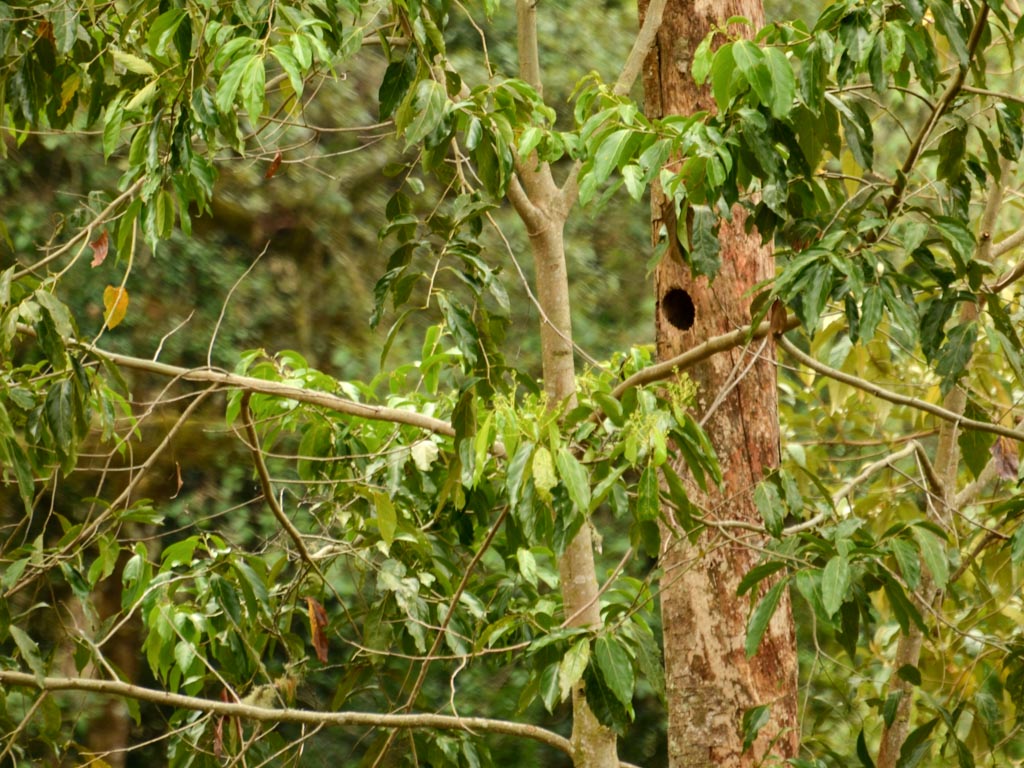
What followed was a spectacular show of the most basic instinct of nature – parenthood. We will now present a photo story of the sequence. But one can best witness the antice through the naked eyes, irrespective of the focal length reach of your camera lens or binocular.
The Mommy Quetzal answers her call of duty
After about 20 minutes of waiting, we finally saw the female Resplendent Quetzal arrive. The Mommy Quetzal had a velvet green body with hints of grey on its sides and its tail. She perched on a branch of a nearby tree for a few moments before heading towards the crater. That crater where she hid her heartbeat – her offspring. Then she put her head inside the crater to feed the babies. She checked the surroundings well before flying away, on her way to do the rest of the day’s tasks. The juveniles need lunch as well, right?
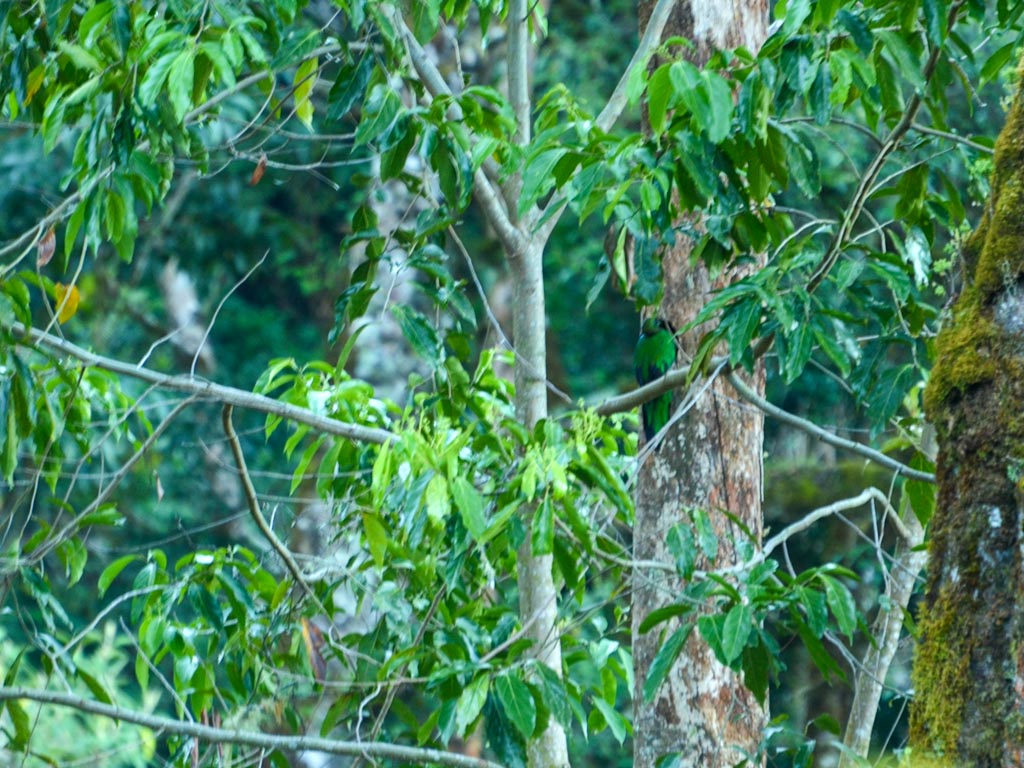
The Daddy Quetzal is no far behind
Offspring are raised well when there is equal participation from both the parents. So, how could the Daddy Quetzal shy away from fulfilling his responsibilities? After a few minutes since the female flew away, landed the male bird. As in the world of birds, the males have more dramatic physical attributes than their female counterparts.
With an even more glowing golden green body with traces of black on its wings and tails, the male Resplendent Quetzal is gifted with some more color splash! Its belly, lower breast and undertail coverts are colored bright red. A crest formed by the feathers on its head and long elongated uppertail coverts crossing over the end of the tail are two other pronounced features of the male Resplendent Quetzal.
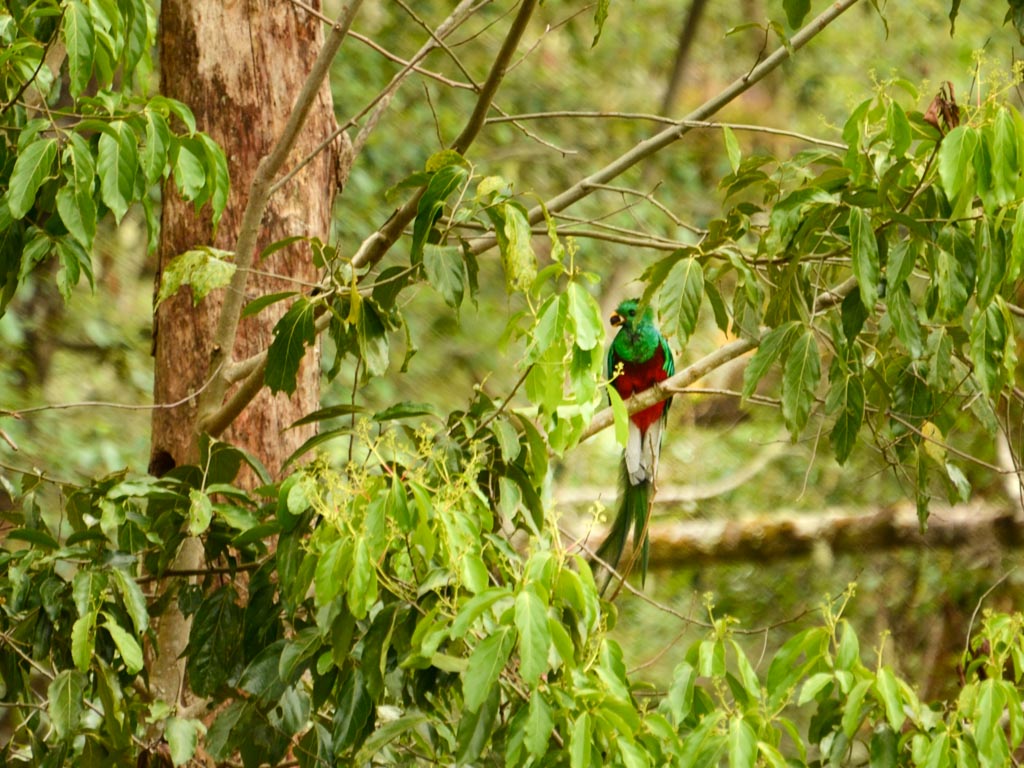
The Daddy Quetzal also put his head into the crater to check in on the kids and then hung around on the nearby branches for a while. Then it flew, but not too far away. For now.
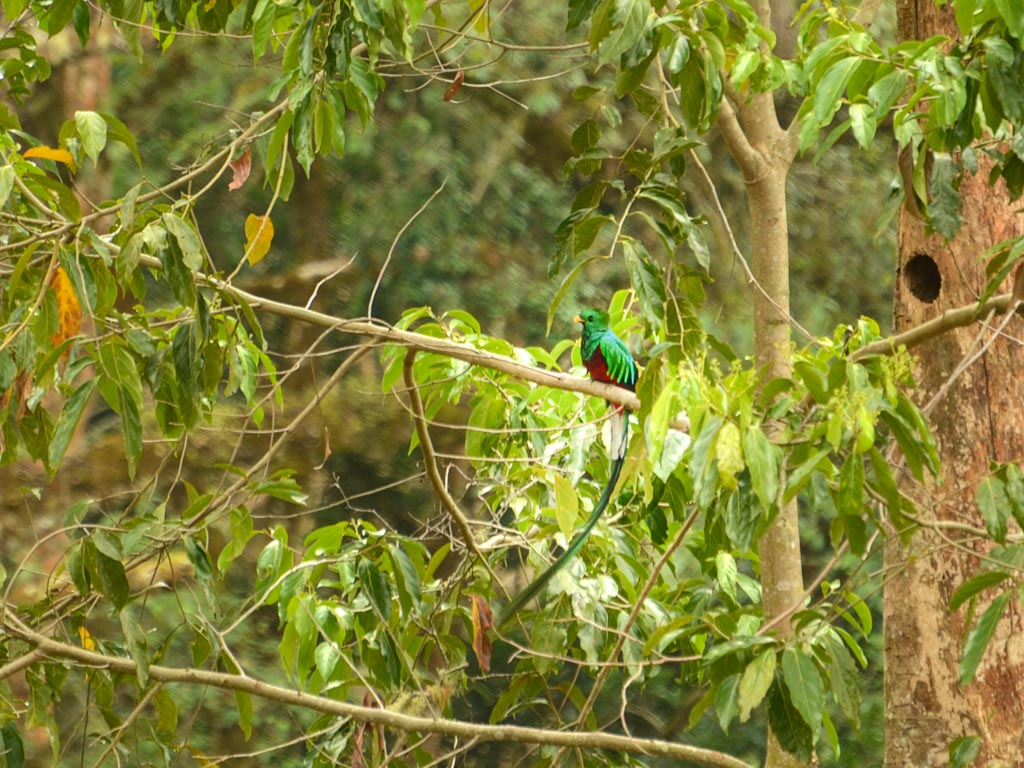
Chilling under the morning sun
The male Resplendent Quetzal flew to the other side of road and placed himself on the edge of the fence. This time, much nearer to its audience. The dawn had by now broken well into the morning. He seemed to relish the rays of the morning sun shining bright on its iridescent body. Before flying away, he made couple of other stops, one at the top of a tree and another of the far end of the fence.
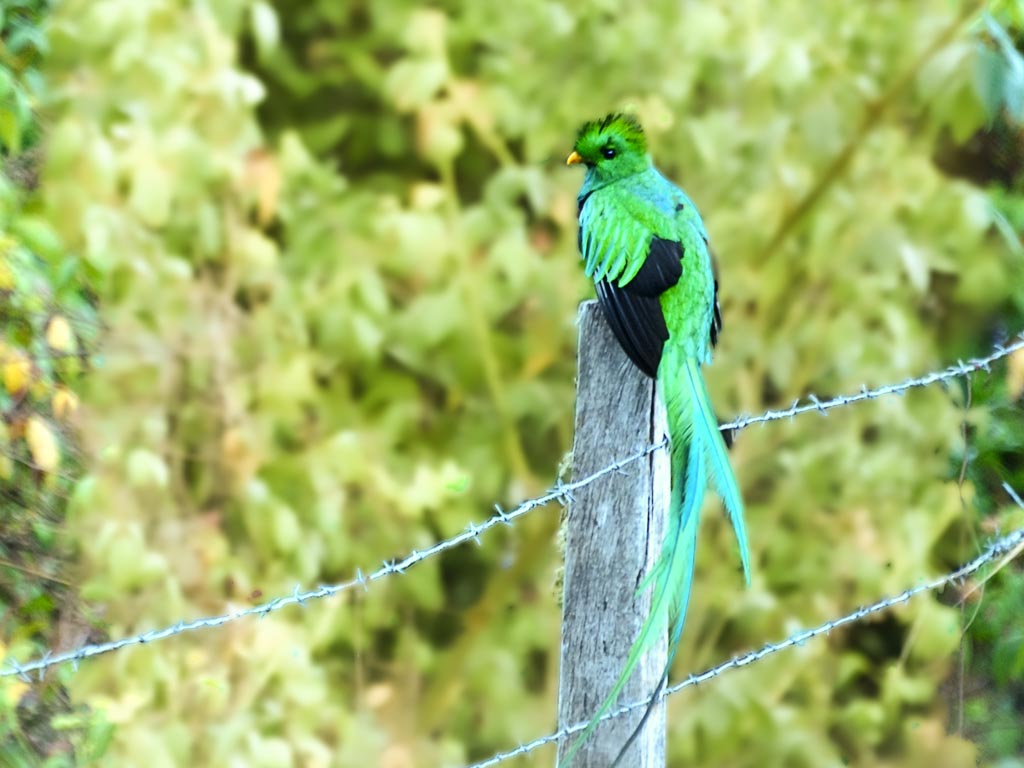
Together at work
We went about walking for some more time, spotting other birds. Then when it was time to head back to the cabin, we thought about checking out that spot again where we spotted the Quetzals in the morning. And to our wonder, our instincts did pay off. This time, we saw both the Mommy Quetzal and the Daddy Quetzal lurking around their precious crater.
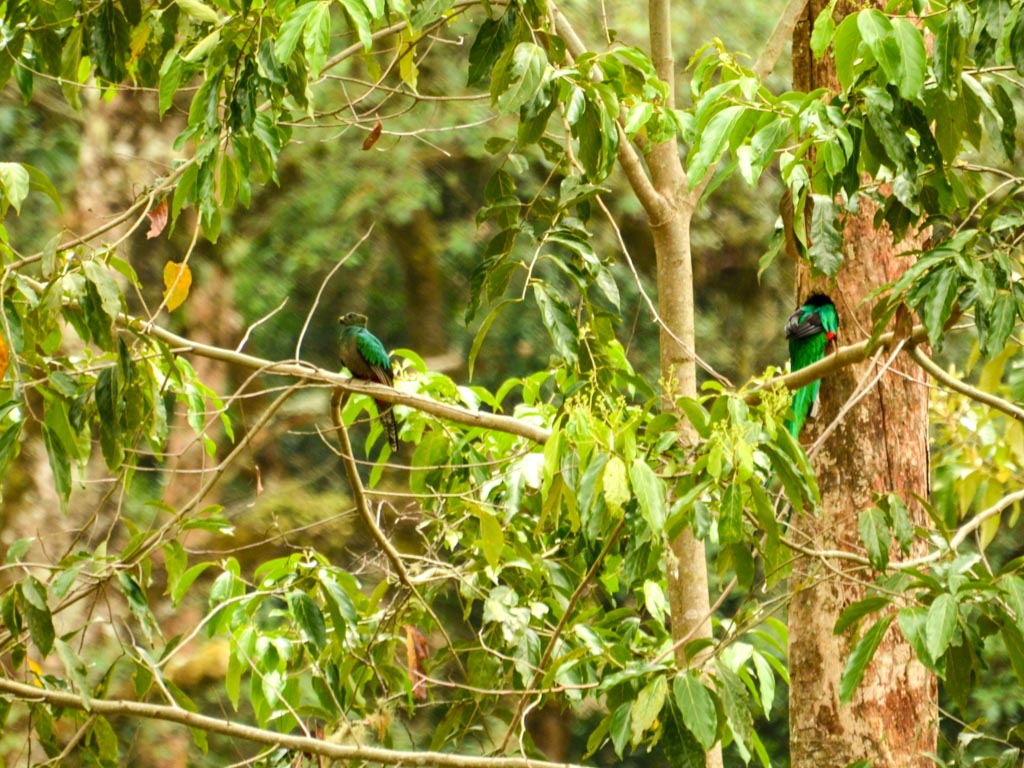
Quetzal Spotting in San Gerardo: Guided Tour
The Hunt
We went on a guided Quetzal Tour during what was not the nesting season, and thus a more difficult time to spot the bird. We had already spent more than an hour looking for Quetzals in their favorite trees but had not spotted any. Our guide eventually found one but it flew away before we could even take a good look at it. Armed with all his knowledge of the bird’s behavior, the guide estimated its flight route and anticipated where it could have gone. So, he took us to the private farm and garden behind his friend’s house down the road. That turned out to be a masterstroke!
The Find
After a quick steep climb up the slope, we were able to enjoy quite the show from a vantage point. A male and a female hanging out on different trees nearby. They were basking in the morning sun and were occasionally eating fruits. We also got to witness some majestic flights as they switched positions from one tree to another to eat the fruits.
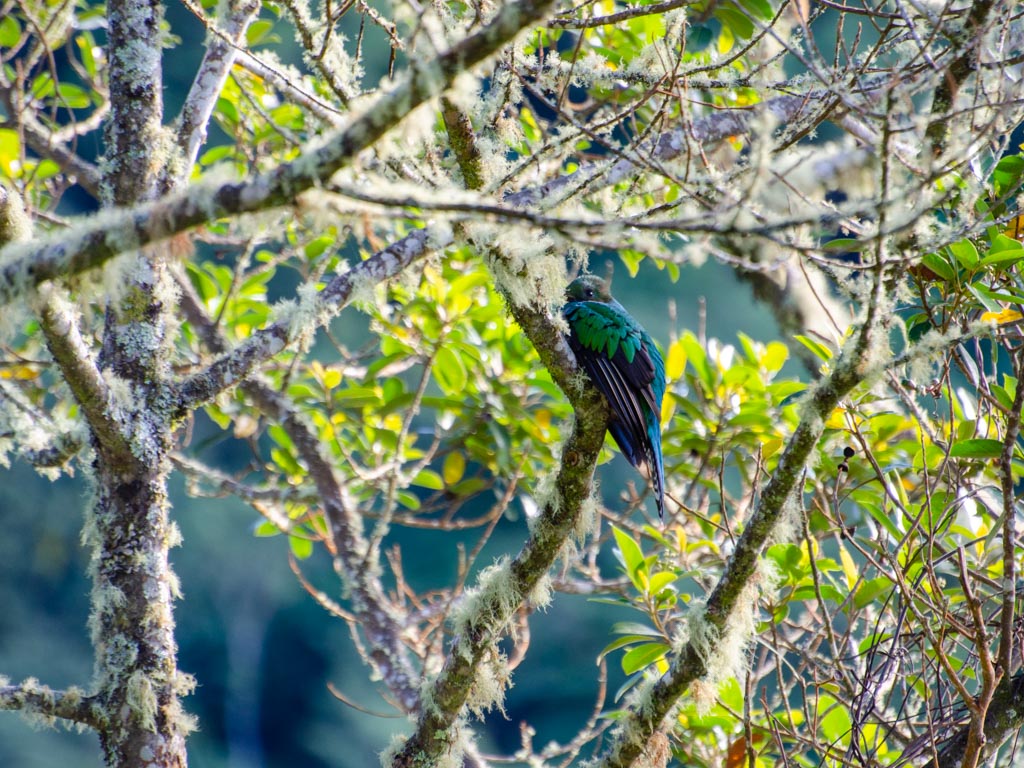
Advantages
These sightings would not have been possible without the knowledge and the local social network of our guide. And one other advantage of a guided tour is that the guide offers his telescope for viewing the spotted birds up close and also for taking photographs, with a high zoomed in view through the telescope.
We were content with our guided Quetzal Tour, and definitely recommend one to you if Quetzal spotting features high on your Costa Rica bucket list.
Bird watching in San Gerardo de Dota
Watching the Replendent Quetzals carry out their daily activities and interact with their families was a wonderful experience. But even if our quest for Quetzal had not come to fruitation, we would still recommend San Gerardo de Dota. Particularly for birding enthusiasts.
San Gerardo de Dota is an idyllic mountain village with year-round moderate climate. Surrounded by cloud forests and accompanied by clear water of Rio Savegre and other waterfalls, this little place provides the perfect setting for many bird species to thrive. During our visit, we came across several other species of gorgeous birds. Emerald Toucanet, Acorn Woodpecker, Red Tanager, several varieties of Hummingbirds are only to name a few.
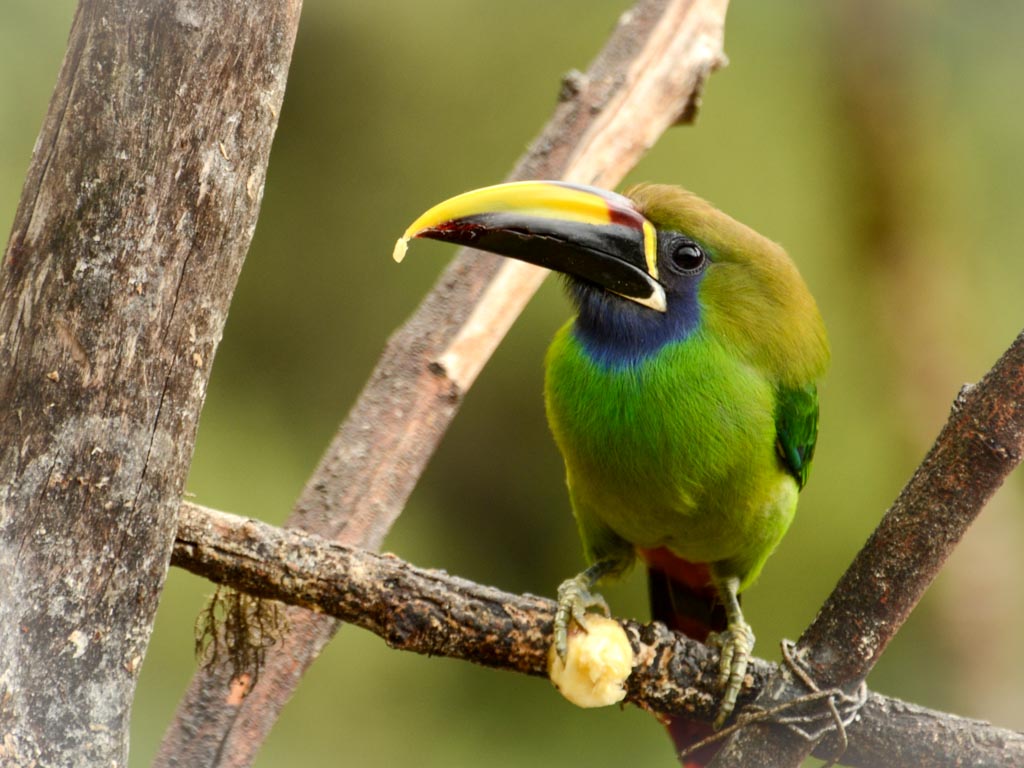
How to reach San Gerardo de Dota
Self-drive car is the best way to reach San Gerardo de Dota. Driving on the Ruta 2, you need to take a right from Cerro de la Muerte. The road condition is great all year round. However, expect bumpy rides on pothole laden paths on certain sections after you take the right. It is a beautiful 2 hour drive (barring the San Jose traffic!). Drive with caution (as always!) as rain can reduce the visibility to a great extent on these curvy roads.
Final Thoughts
San Gerardo de Dota is a paradise for birders. This might be the place where you finally get to spot the elusive Resplendent Quetzal. But the beauty of birding lies in the mystery of not knowing what you are going to find. So, whatever the outcome is, do enjoy the experience of your quest for Quetzal in San Gerardo de Dota. Also, as a bonus, this pastoral town is an excellent choice for spending a few tranquil days amidst nature.
Like this post? Pin it!
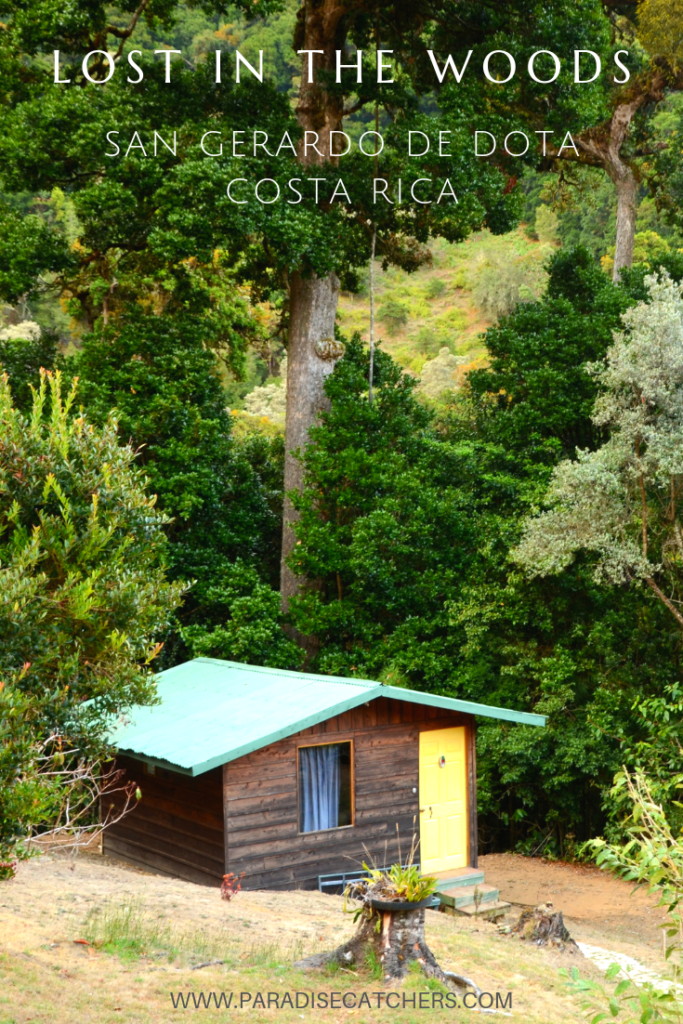
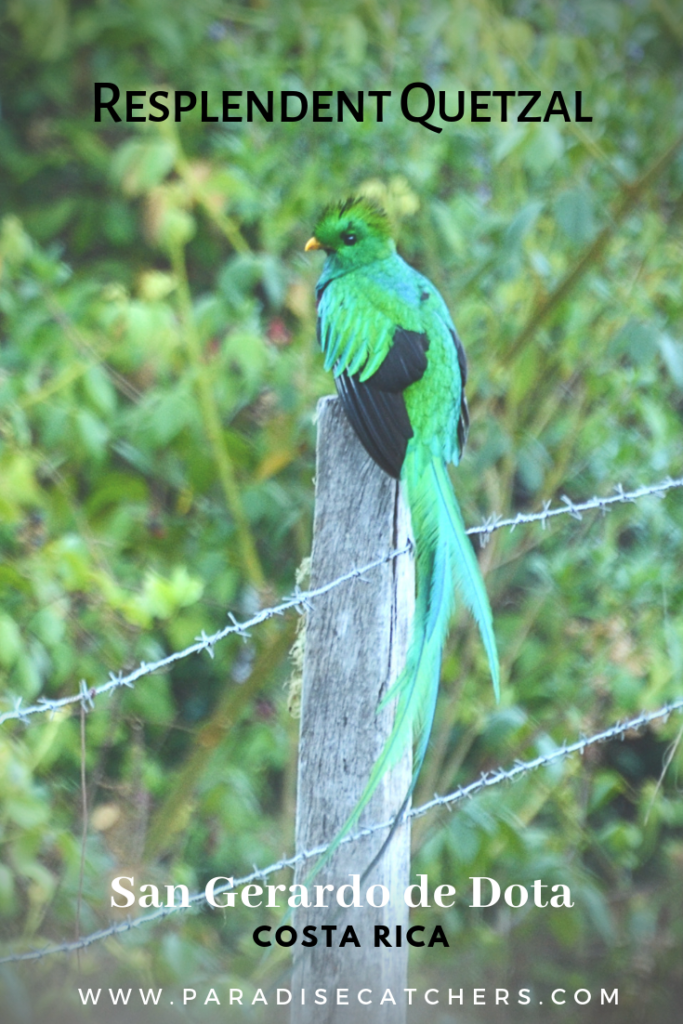
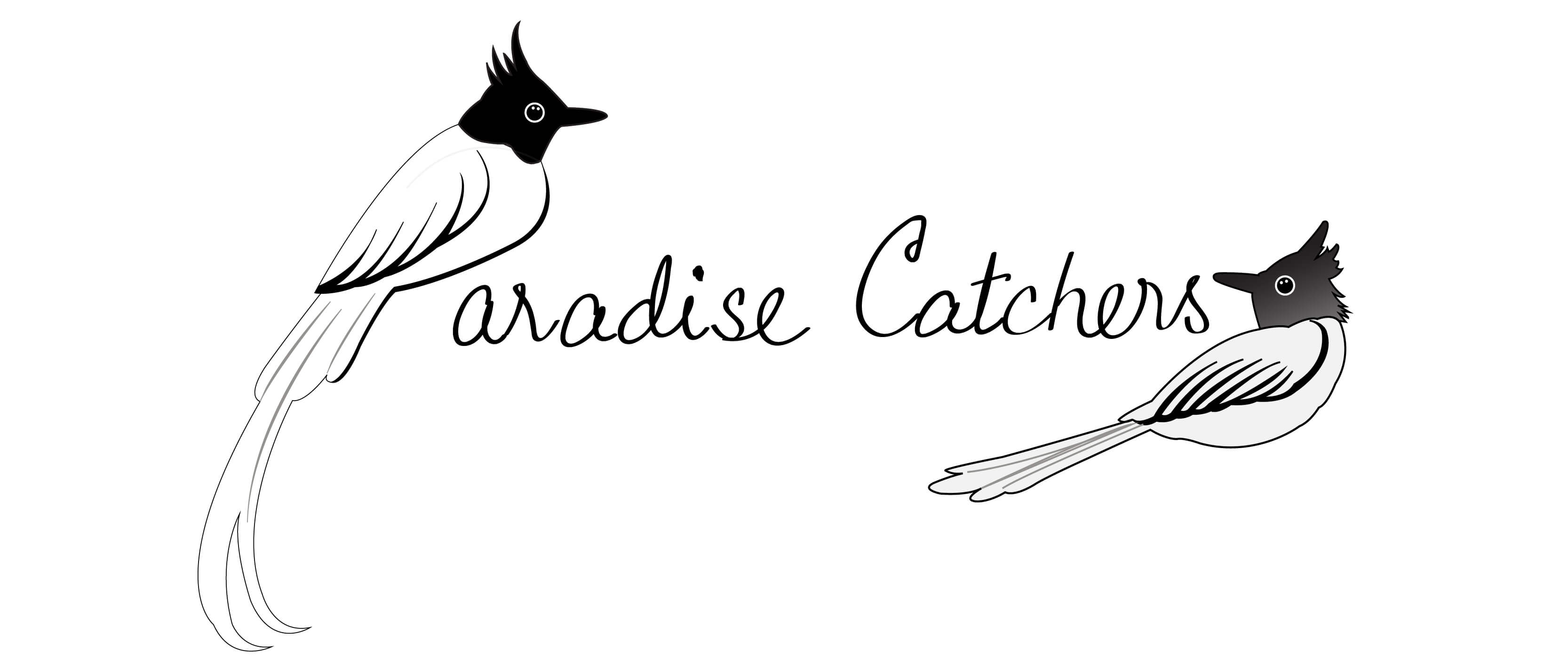
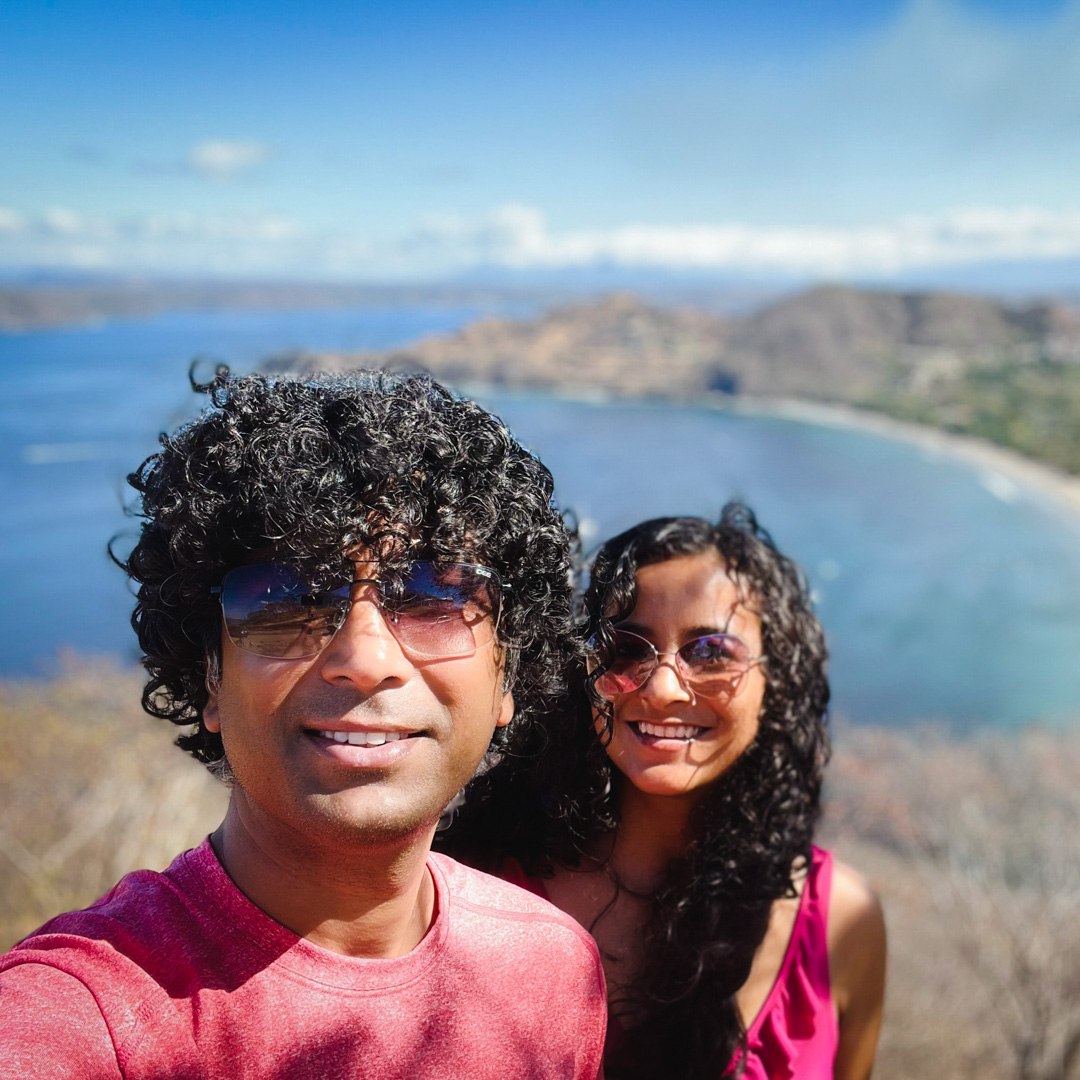
Other than a parrot, I don’t think I’ve ever seen another green bird. And I’ve certainly never seen a parrot in the wild. These guys are absolutely gorgeous, and they truly blend right into their lush surroundings. Amazing!
Yes, it’s amazing how they blend into their habitat – nature at its best! 🙂
Wow! These looks like a fantastic adventure! What epic photos. I also love the design of your blog <3
Aww, thanks Anna! 🙂
The birds are so beautiful! That cabin certainly does look like a box, but I love the remoteness of it! I have friends that want to retire in Costa Rica, their photos always look so beautiful!
Hi Andi, we live in Costa Rica, not retired yet (far from it probably) But we can totally imagine why your friends wish to retire here. This country is truly beautiful. 🙂
Your photos are absolutely GORGEOUS! Wow! Also, I love love love your logo! And your AirBNB is to die for <33
Thanks so much Anna! 🙂 We had the vision for our logo design, which we had described to a talented friend/colleague – he gave shape to our ideas and created this logo that you see on the website now.
WOW! you got to see a Quetzel. I did a could of jungle hikes while I was in Central America, and I was told about them, but I never managed spot one. You’re so lucky!
Hi Becki, yes agree, we were lucky to spot this elusive bird. This was our first meeting with the Resplendent Quetzal in several jungle hikes across different regions in Costa Rica. However, they do not live in all those regions. Hope to see this species again. 🙂
Wow! I can’t believe you saw a Quetzal! Absolutely incredible!!!! Very wonderful and so glad that you got to go!
Thanks Cate, yes it was incredible! 🙂
Hello, which guide did you use for the guided tour? We are planning a trip to costa rica to hopefully see quetzal. Thank you!
Hi Sharon, we had booked the Quetzal Spotting tour with Savegre Hotel in San Gerardo de Dota. You can ask for Marino Chacon. He wasn’t available for our dates, but have heard great things about him. However, even if he is not available, I’m sure you’ll be assigned a trusted and expert guide, like we were 🙂